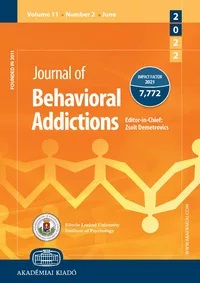Neural and behavioral correlates of sexual stimuli anticipation point to addiction-like mechanisms in compulsive sexual behavior disorder
Neural and behavioral correlates of sexual stimuli anticipation point to addiction-like mechanisms in compulsive sexual behavior disorder
Author(s): Benny Liberg, Katarina Görts Öberg, Jussi Jokinen, Josephine Savard, Cecilia Dhejne, Stefan Arver, Johannes Fuss, Martin Ingvar, Christoph AbéSubject(s): Behaviorism
Published by: Akadémiai Kiadó
Keywords: compulsive sexual behavior disorder; hypersexual disorder; sex addiction; functional MRI; anticipation; sexual stimuli
Summary/Abstract: Background and aims. Compulsive sexual behavior disorder (CSBD) is characterized by persistent patterns of failure to control sexual impulses resulting in repetitive sexual behavior, pursued despite adverse consequences. Despite previous indications of addiction-like mechanisms and the recent impulse-control disorder classification in the International Classification of Diseases (ICD-11), the neurobiological processes underlying CSBD are unknown. Methods. We designed and applied a behavioral paradigm aimed at disentangling processes related to anticipation and viewing of erotic stimuli. In 22 male CSBD patients (age: M = 38.7, SD = 11.7) and 20 healthy male controls (HC, age: M = 37.6, SD = 8.5), we measured behavioral responses and neural activity during functional magnetic resonance imaging (fMRI). The main outcomes were response time differences between erotic and non-erotic trials and ventral striatum (VS) activity during anticipation of visual stimuli. We related these outcomes with each other, to CSBD diagnosis, and symptom severity. Results. We found robust case-control differences on behavioral level, where CSBD patients showed larger response time differences between erotic and non-erotic trials than HC. The task induced reliable main activations within each group. While we did not observe significant group differences in VS activity, VS activity during anticipation correlated with response time differences and self-ratings for anticipation of erotic stimuli. Discussion and Conclusions. Our results support the validity and applicability of the developed task and suggest that CSBD is associated with altered behavioral correlates of anticipation, which were associated with ventral striatum activity during anticipation of erotic stimuli. This supports the idea that addiction-like mechanisms play a role in CSBD.
Journal: Journal of Behavioral Addictions
- Issue Year: 11/2022
- Issue No: 2
- Page Range: 520-532
- Page Count: 13
- Language: English

